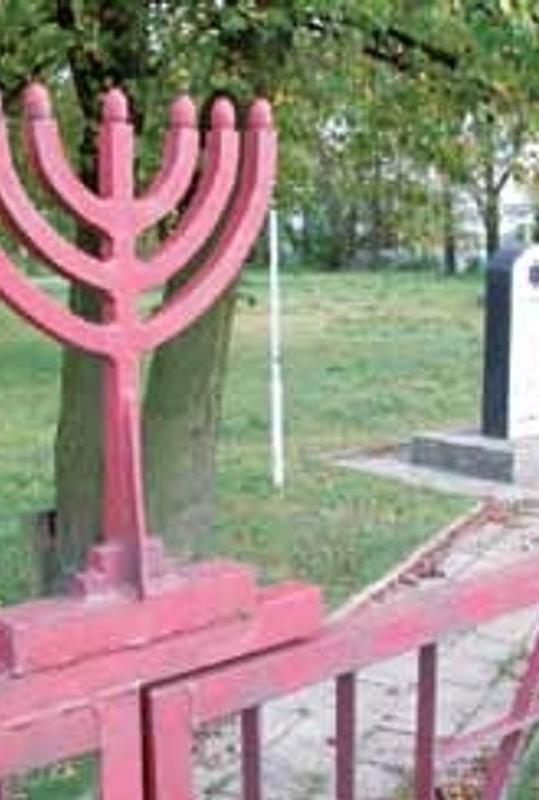New Jewish cemetery (Lubelska Street)- It was established at the beginning of the 20th century. On the road leading in the direction of Czemierniki, at a distance of about 2 km from the city center. During World War II, the Germans carried out executions on it. After the liquidation of the ghetto, they devastated the cemetery, after 1944. while matzos were stolen and then sold for construction purposes and grinding wheels. In the first half of the 1990s., on the initiative of Pesach Tunkielszwar, with the cooperation of the Radzyn Landsmanschaft in Israel and thanks to the support of local authorities, cleanup work was carried out at the necropolis. In 1995. A stone monument dedicated to the memory of Holocaust victims was unveiled. It has the shape of a stone slab stylized as a matzeva, with an engraved Star of David and inscriptions in Hebrew, Polish and English: "To the eternal memory of the Jews of Radzyn, murdered by the Nazis in 1939-1945. Honor their memory!This cemetery, established in the early 20th century, served the Jewish community until 1941." In the fenced and wooded area of the cemetery, which covers an area of 0.69 hectares, about ten tombstones, mostly damaged, and a few fragments of broken slabs have survived. In 2008. A matzeva previously converted into a grinding wheel was brought to the cemetery.In 2019-2022, more than 70 matzevot were found during construction work near the former Gestapo detention center. After the inventory, they were placed in the cemetery.Holocaust - 9 September 1939., during a German air raid, a part of the city inhabited by the Jewish population was bombed. At the beginning of October, along with the Red Army units retreating from Radzyń, several hundred Jews - mostly young people - fled to the east. On December 9, some of Radzyn's Jews were relocated to nearby Slawatycze and Miedzyrzec.In April 1940. Most of them have returned to their homes. Soon in Radzyń, the Germans established a Judenrat (headed by David Lichtenstein) and a Jewish Order Service. Most of the Jews residing in Radzyń were forcibly employed on local farms, as well as in cleaning work in the city. In the summer of 1940. All Jews were resettled in the former Jewish quarter, where the Germans created an open ghetto in the quarter between Kozia Street (now Dabrowski Street), 3 Maja Street (now Armii Krajowej Street), Szkolna Street (now Pocztowa Street) and Rzeźnikowska Street (now Gwardii Street). The liquidation of the ghetto began in the fall of 1942. On September 20 or 22, the Gestapo shot outside the city about 200 Jews from the ghetto, while deporting about 800 Jews to the Treblinka death camp. From October 14 to 16, the Germans searched for Jews hiding in the city.They captured about 1,000 people, who were then sent to the ghetto in Miedzyrzec, from where they deported all of them to Treblinka on October 27. It is estimated that about 50 residents of the Radzyn ghetto survived the Holocaust, some thanks to the help of the Poles who were hiding them, and some - in the surrounding forests, where they formed partisan units. A group of one hundred Jewish ghetto escapees, hiding in two bunkers in the woods between Radzyn and Kock, was broken up by the Germans. The remaining 15 Jews, led by Yitzchok Kleinman, undertook armed actions against the occupiers and Polish collaborators. Another group of Jewish partisans, led by Leib and Leyzer Panczak, fought in the forests between Radzyn and Wisznice. In the early summer of 1944. were murdered by Polish partisans.After the war - About 20 surviving Jews returned to Radzyń, but they soon mostly left the city. In 1944-1946 there were attacks on returning Jews in Radzyn.In September 1946. A Jew from Radzyń was murdered on a train traveling from Łuków to Siedlce.
5. Radzyń Podlaski - Nowy cmentarz żydowski (ul. Lubelska)
Stories
Radzyń Podlaski - New Jewish cemetery (Lubelska St.)
Jewish History Tours

Powered by Clio Muse Tours
Powered by Clio Muse Tours
